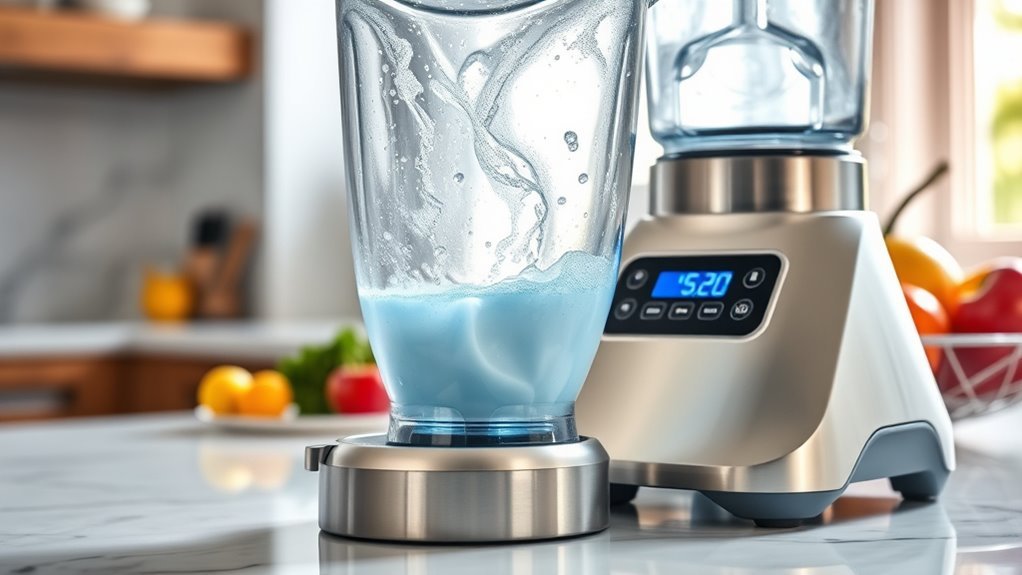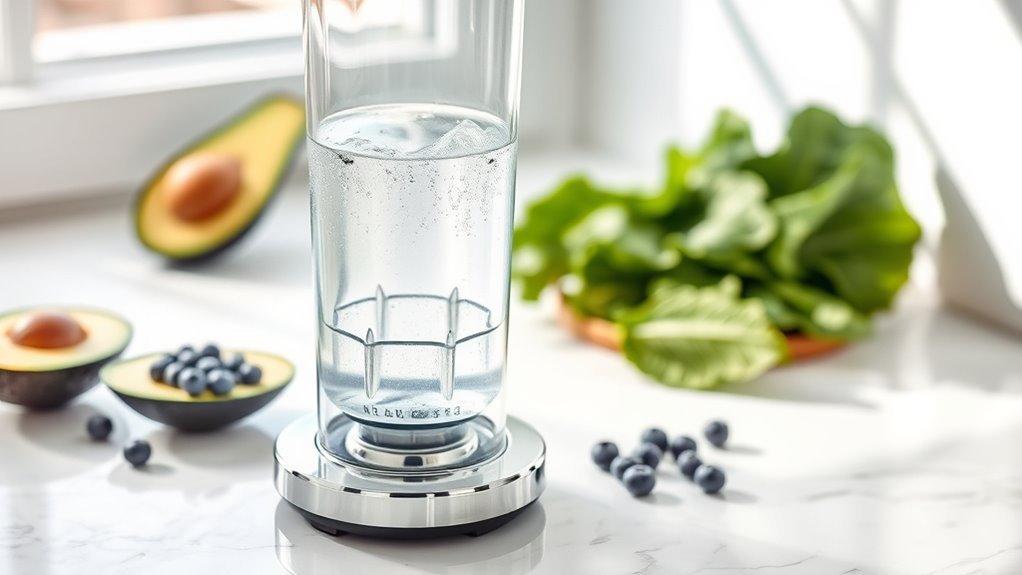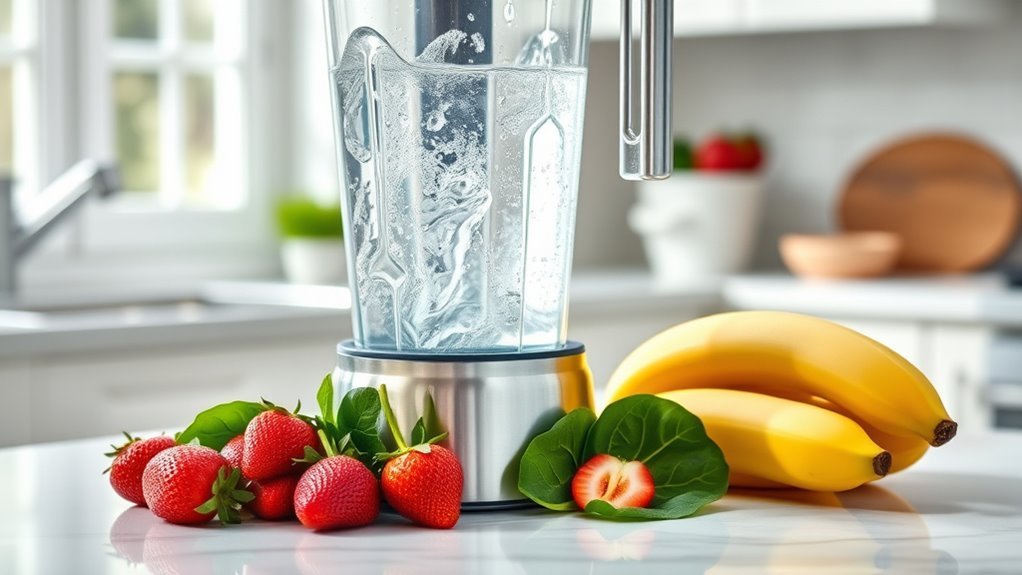We’ve all been there—staring at a crusty blender pitcher after making that delicious smoothie, dreading the cleanup ahead. But what if your blender could clean itself? That’s the magic behind self-cleaning blenders. They’re not just convenient time-savers; they’re revolutionizing how we approach kitchen cleanup. The technology might seem mysterious, but it’s actually quite clever in its simplicity. Let’s take a closer look at what’s happening under the lid.
The Technology Behind Self-Cleaning Blender Systems

The amazing technology behind self-cleaning blenders might seem like magic, but it’s actually pretty straightforward once you understand what’s happening inside that container.
It’s basically using the blender’s own power against the mess it created!
Here’s how it works: you fill the blender about halfway with warm water, add a drop of dish soap, and press that dedicated self-clean button.
The Replenish model, for instance, activates a 15-20 second cycle that’ll blend the soapy water at high speed.
This creates a powerful vortex that, well, basically scrubs the interior surfaces for you.
I think the cleverest part is how they’ve reprogrammed the regular blending function—the same motor that makes your smoothie is now your dishwasher.
This self-cleaning feature is particularly advantageous for high-performance blenders, as it helps maintain their durability and efficiency.
From Cup to Smoothie: The Automated Blending Process
Imagine this: you’ve just peeled back the lid on a prepackaged cup filled with frozen fruits, veggies, and maybe a sprinkle of cinnamon or handful of blueberries.
What happens next?
Well, we simply place the cup into our Replenish blender and watch the magic unfold.
The machine adds exactly one ounce of water—just enough to transform those ingredients into a perfect smoothie without any stuck-on food.
For 45 seconds, the blender works through two distinct cycles, pulverizing everything into vitamin-packed goodness.
The best part? We don’t need to worry about leftover residue.
Once your smoothie is ready, the self-cleaning feature kicks in, giving the system a deep clean.
No scrubbing required!
It’s like having a personal smoothie bartender who also cleans up after themselves.
This self-cleaning technology is a key feature in high-performance blenders, offering enhanced convenience for daily use.
Maintaining Your Self-Cleaning Blender for Optimal Performance

Keeping your self-cleaning blender in top shape doesn’t have to be a chore, even with all its magical automated features.
Right after use, give it a quick rinse with warm water, then add soap and water (about a quarter full) and run the self-cleaning cycle for 15-20 seconds.
Works like a charm!
For those stubborn residues—you know, like when you make nut butter—a bottle brush might be your new best friend.
And that cloudy buildup? White vinegar mixed with water (3:1 ratio) will clear that right up.
For weekly maintenance, we’ve found that baking soda paste works wonders on stains.
Just scrub gently, then rinse with vinegar.
It’s like giving your blender a spa treatment—and trust me, it’ll thank you with years of perfect smoothies!
Business Benefits of Self-Cleaning Blenders in Office Environments
Office culture is changing, and self-cleaning blenders are leading a quiet revolution in workplace wellness.
We’ve seen companies replace those tempting chips and candy bars with nutrient-packed smoothies that employees actually enjoy.
Unlike traditional immersion blenders that require dismantling to clean your blender after each use, self-cleaning models eliminate this hassle completely.
The business benefits are impressive.
With 45-second blend cycles and no buildup of minerals to worry about, office managers save countless maintenance hours.
Plus, when employees purchase pre-packaged ingredient cups, companies provide wellness options without bearing the full cost.
I think the most valuable advantage, though, is how these machines integrate with existing food service distribution—making healthy choices accessible even during those grueling 12-hour workdays.
Well, that and happier, more energized teams!
Comparing Self-Cleaning Blenders to Traditional Cleaning Methods

When it comes to cleaning your blender, traditional methods feel like they’re straight out of the dark ages compared to today’s self-cleaning models.
Instead of filling with hot water, adding soap, and running a quick cycle, you’re stuck with the multi-step hassle of rinsing, scrubbing, and repeating.
Remember that bottle brush you’ve been using to scrub those stubborn residues?
Well, you can probably toss it.
Self-cleaners like the Replenish handle everything in one automated 45-second cycle.
No more awkwardly reaching into the container with a brush to scrub at those oily bits that just won’t budge!
I think the biggest difference is time—traditional cleaning might take several minutes of your attention, while self-cleaning blenders do the work while you’re already moving on with your day.
Frequently Asked Questions
How Does the Self-Cleaning Function Work?
We’ve designed our self-cleaning function mechanism to automatically blend warm water and soap after use. The process steps involve running the blades for 15-20 seconds. For efficiency tips, just add water and soap!
Can Blenders Clean Themselves?
Like magic in your kitchen, yes! We’ve found some blenders clean themselves through automated cycles. User feedback suggests effectiveness debate persists, but models like Replenish challenge blender myths with their self-cleaning capabilities.
How Does Whirlpool Self-Cleaning Work?
We’ve seen Whirlpool’s self-cleaning technology evolve over time, using high-speed blade rotation to create a soapy vortex that cleans residue. Their market impact continues through automated cleaning cycles and innovative design.
How Does a Self-Cleaning Surface Typically Work?
We combine water with soap, creating turbulence that scrubs away residue. Modern surfaces use biomimetic designs, surface hydrophobicity, and photocatalytic coatings to repel dirt or break it down when activated.

